London’s Salt Beef Beigel
What in the world is a beigel?
The word… was imported into English from the Yiddish beygl, which in 1919 was spelled beigel and in 1932 was shortened to bagel.
Safire, W. (1994, June 12) ON LANGUAGE; Keep Your Eye Upon The Bagel. Retrieved from https://www.nytimes.com/1994/06/12/magazine/on-language-keep-your-eye-upon-the-bagel.html
In London, the older spelling holds on Brick Street, where two bakeries a few doors down from each other have been selling bagels, or beigels, for decades. As we’ve seen with signature sandwiches from other cities, such as Philadelphia’s Cheesesteak, LA’s French Dip, or even Chicago’s Maxwell Street Polish, each of the two bakeries known for originating this sandwich has its own regulars and partisans.
There’s Beigel Bake, with the white sign, a little better known, newer, seemingly more popular, open since 1977. And there’s Beigel Shop, older, vastly older, originally opened in 1855, but also apparently the more flexible of the two, selling non-kosher and non-traditional foods such as ham, bacon, sausage, and rainbow beigels similar to the rainbow bagels that popped up in Brooklyn a few years ago.

Beigel Bake, by Flickr user Steve Cadman https://www.flickr.com/photos/albedo/100011442 
Beigel Shop, by Flickr user albedo https://www.flickr.com/photos/albedo/100011442
Both are open all night; both serve bagels with a variety of fillings, though Beigel Bake also served a number of other familiar savory Jewish baked goods–rye bread, challah, onion rolls–as well as various pastries. What both of them are known for though, and what keeps people coming back to Brick Lane at all hours of the night, are the Salt Beef Beigels.
Salt Beef Beigels are bagels–what can I say, I’m American–split open, stuffed with thick-sliced slow-simmered warm corned beef, finished with spicy English mustard and sliced gherkins. A fresh, warm-from-the-oven, chewy bagel, stuffed with salty fatty soft corned beef cut with the acidity of the pickled gherkin, and with a dose of sinus-clearing mustard to wake up the senses. Sounds like just the thing to help soak up a night of bad decisions.
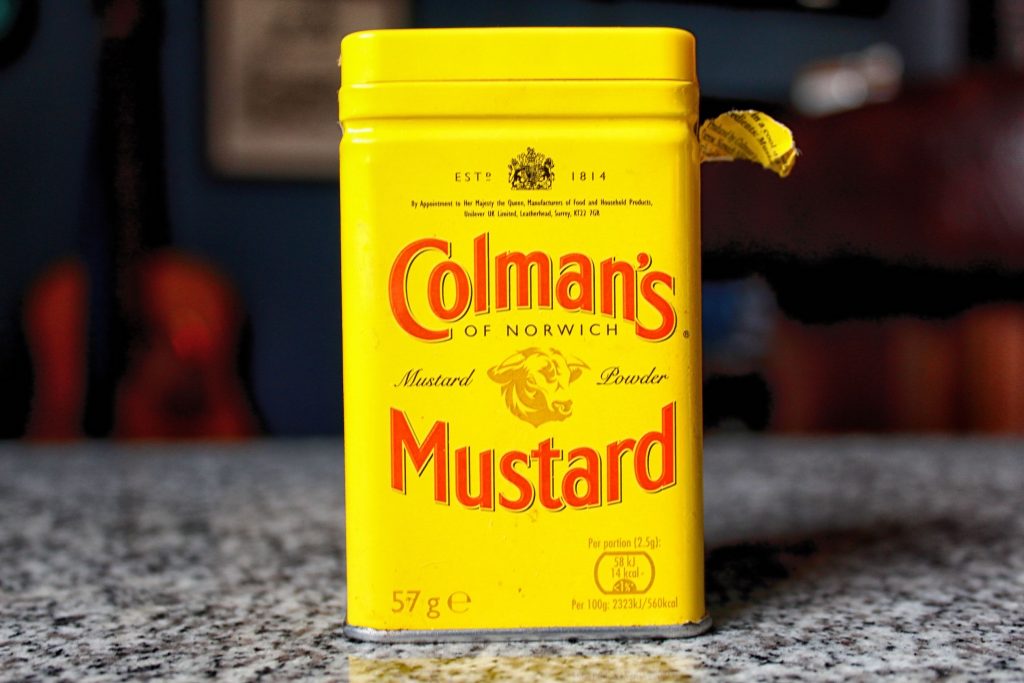
The mustard will come later. Let’s start with the salt beef.
Salt Beef
This is a full packer cut brisket, a bit over 15 pounds worth.
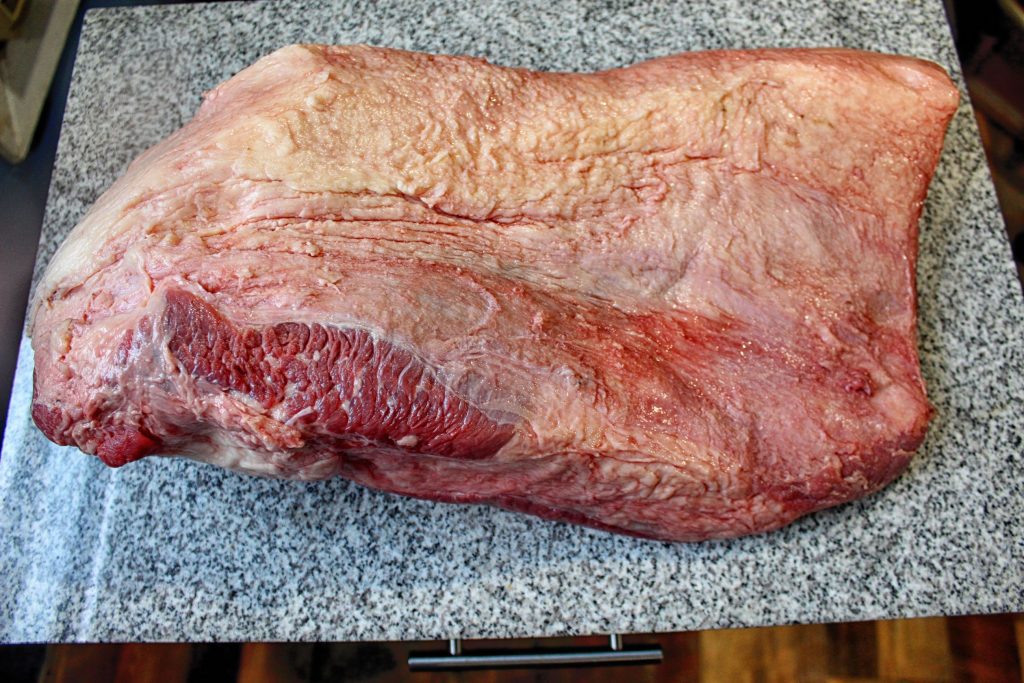
There’s a lot of fat on this cut of meat, and two different muscles–the point and the flat. The point is a smaller, rounder section, more marbled with fat, that makes for great burnt ends if you’re a barbecue guy. The flat is a flatter (obviously), leaner, larger, longer section that is great for corned beef. There’s a nice thick layer of fat between the two so with some careful knife work they’re easy to separate. At which time you can also remove a lot of the fat. Yes yes, I know, fat is flavor. Don’t worry, there’s plenty. You don’t need it all.
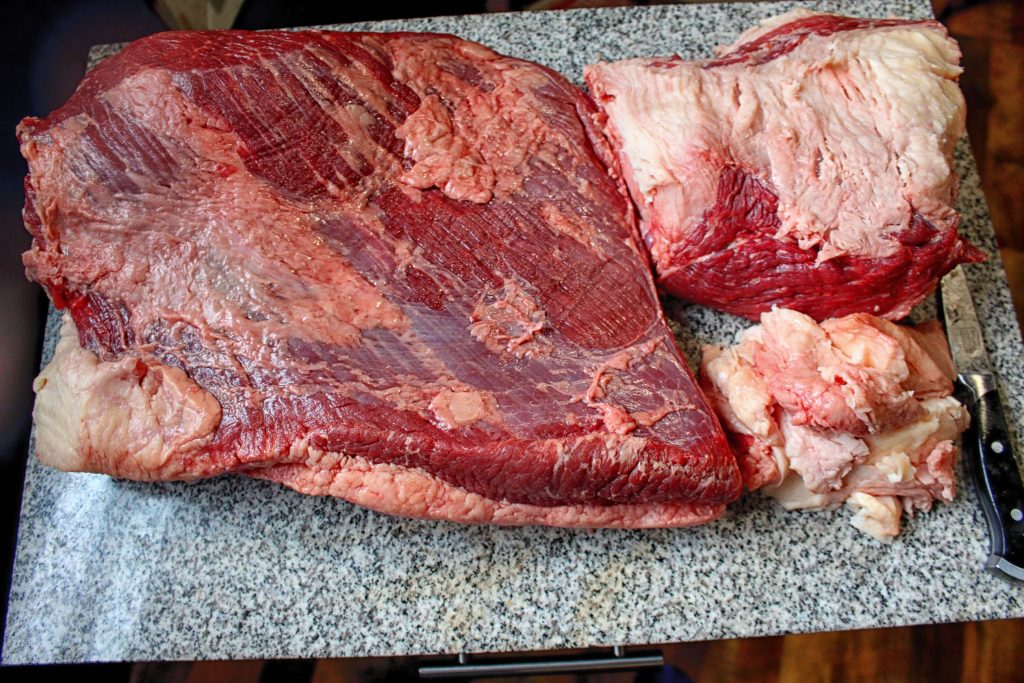
Even separated, I’ve got 10 pounds of flat here, with a 4-5 pound point and plenty of trimmed fat. The flat is so large in fact that I need to cut it in half to fit it into the bucket I’m brining it in. The brine I’m using consists of water, salt, granulated sugar, curing salt, juniper berries, bay leaves, star anise, black peppercorns, mustard seeds, coriander seeds, and garlic, and the meat will spend a week and change in it.
During the cure, the brisket undergoes some fundamental biochemical changes. The salt in the brine draws moisture out of the meat, which draws the brine and its flavor and antimicrobial properties back in. The sodium nitrite (otherwise known as saltpeter) in the curing salts preserves not only the meat but the reddish color of the meat, which results in the brilliant pinkish-red color of cured meats like ham, Polish sausage, and of course corned beef.
After a week to ten days of curing, the meat has taken on as much of the flavor as it’s going to and is ready to be cooked. A salt beef or corned beef is generally simmered in water with aromatic elements such as onion and celery. Brisket needs to be cooked for a long time in order for the collagen in the connective tissued to be rendered into gelatin, creating the pull-apart texture of a well-done brisket rather than the rubbery texture of an undercooked one.
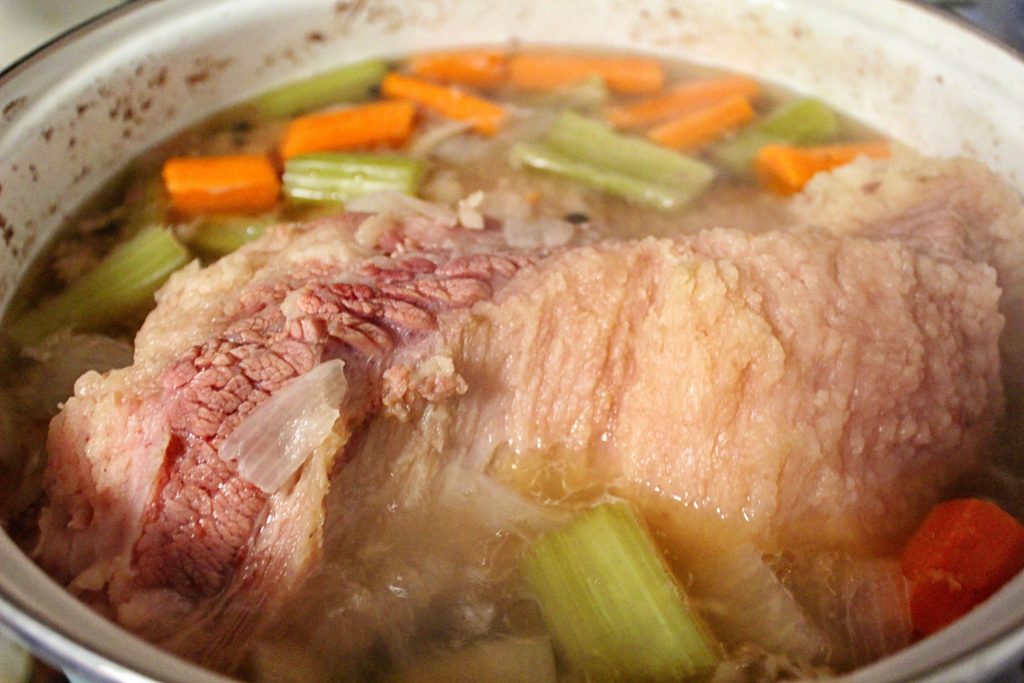
I simmered my salt beef brisket flat in water with onion, carrot, celery, black peppercorns, juniper berries, and bay leaves for around 4 hours. This was the result.
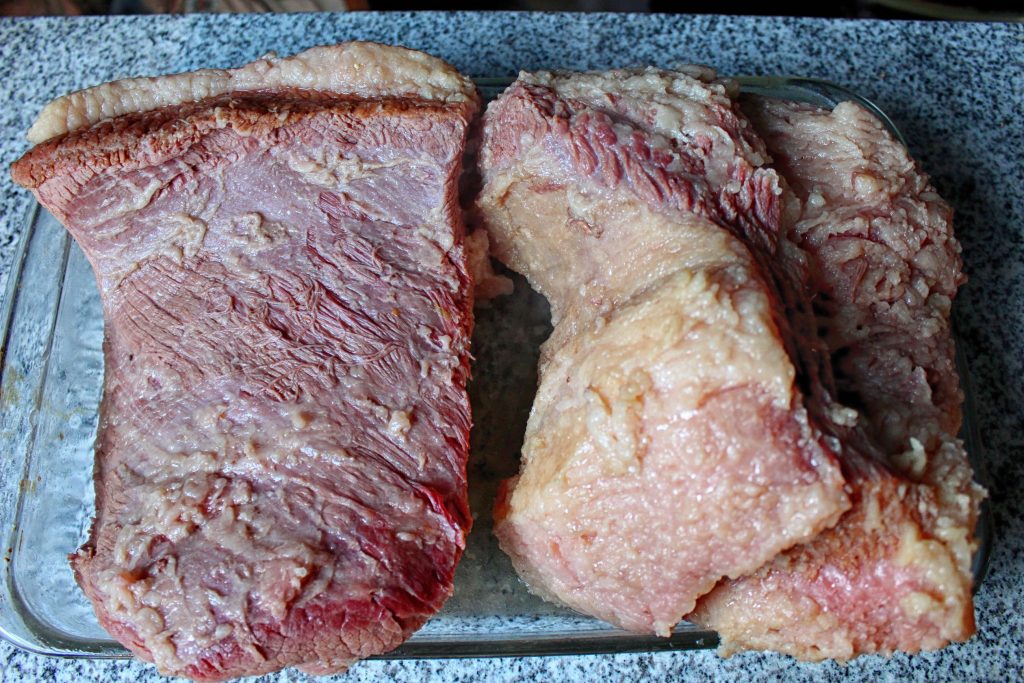
There’s still a bit of the point on that right half of the flat, and a large layer of fat in the middle. The left half is pure brisket flat though, and ready to be sliced thickly against the grain and made into sandwiches. First, though, we’ll need some bagels.
Bagels
Bagels are a bit of an odd duck when it comes to bread products, crusty and chewy, savory yet just a tiny bit sweet. It all has to do with how they are prepared. Bagels start with a low-hydration dough, around 55%, made with strong high-gluten flour and a fine sugar like caster sugar or possibly malt extract. They are shaped into rings, boiled in water mixed with yet more sugar or malt extract, sometimes even some lye, and then baked at high heat. The boiling part of the process creates some rise but then sets the bagels final size and shape, also coating the surface with moisture that allows a firm crust to form. By limiting the size of the rise, boiling also ensures the inside of the bagel will remain somewhat dense and chewy.
Finally, that dip in sugary water leaves a sticky surface perfect for adhering toppings such as sesame seeds or poppy seeds to the bagel.
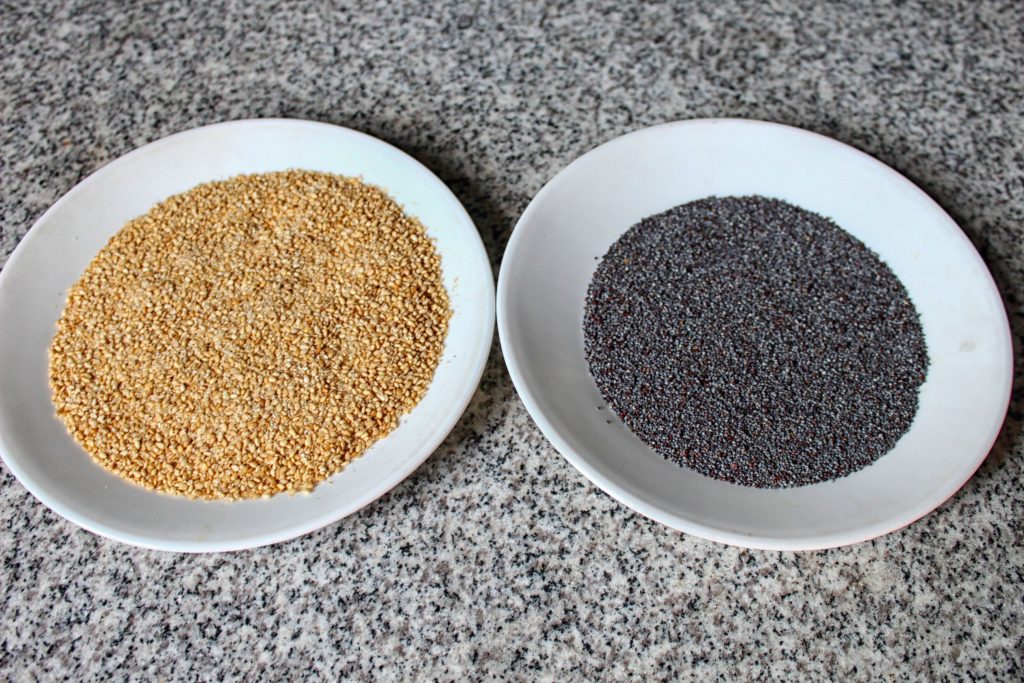
Shaping a bagel isn’t difficult, per se, but it requires a lot of practice to get it right. The dough, a very rigid stretchy dough, is rolled out to a tapered cigar shape, the ends are twisted together and rolled quickly to seal a ring. Then the shaped bagel is allowed to proof for a while longer before boiling. My early attempts were ugly but by the time I was done making a dozen of them they were… somewhat less ugly.
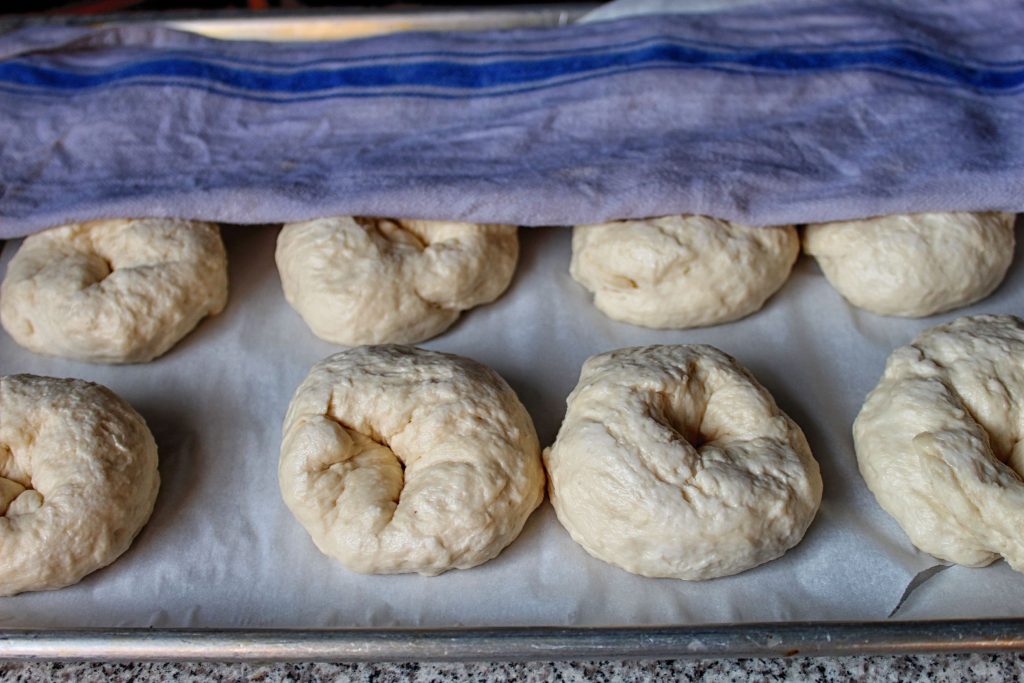
For the boil, I have heard everything from 30 seconds to several minutes per side. I did 2 minutes per side, then a dip into the seed of choice (or not, for plain bagels). I baked them at 450° F for 17 minutes on one side, flipped them over and baked for another 12 minutes on the other side. My oven has been a bit temperamental of late and doesn’t hold its temperature consistently. I’d have liked some better browning. But I think they turned out fairly well.
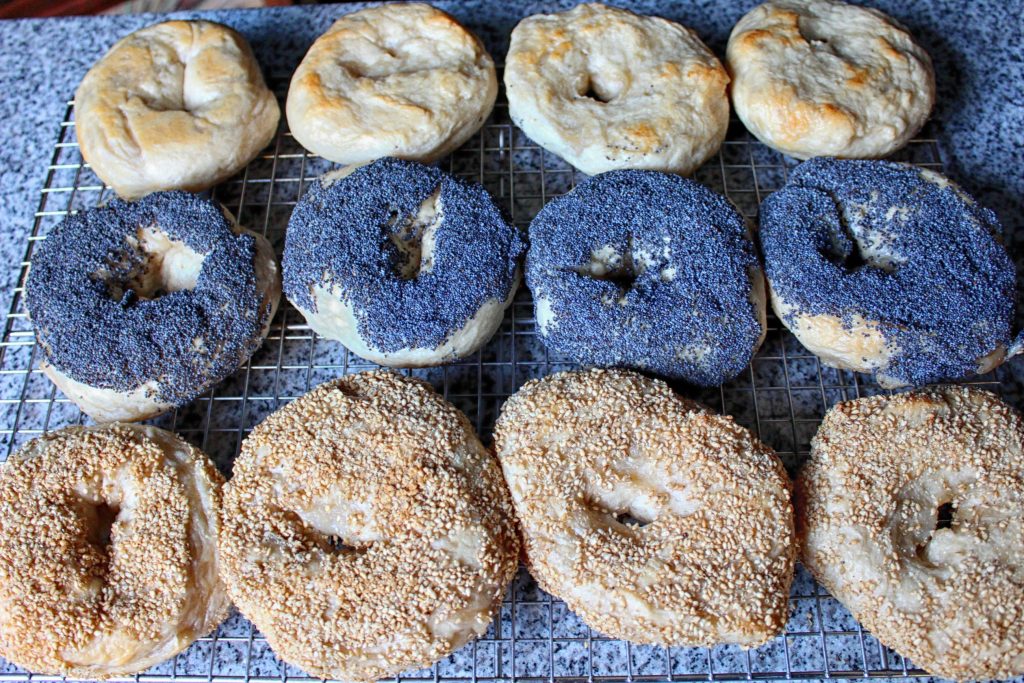
Part of the inconsistent browning was likely due to my amateur shaping technique.
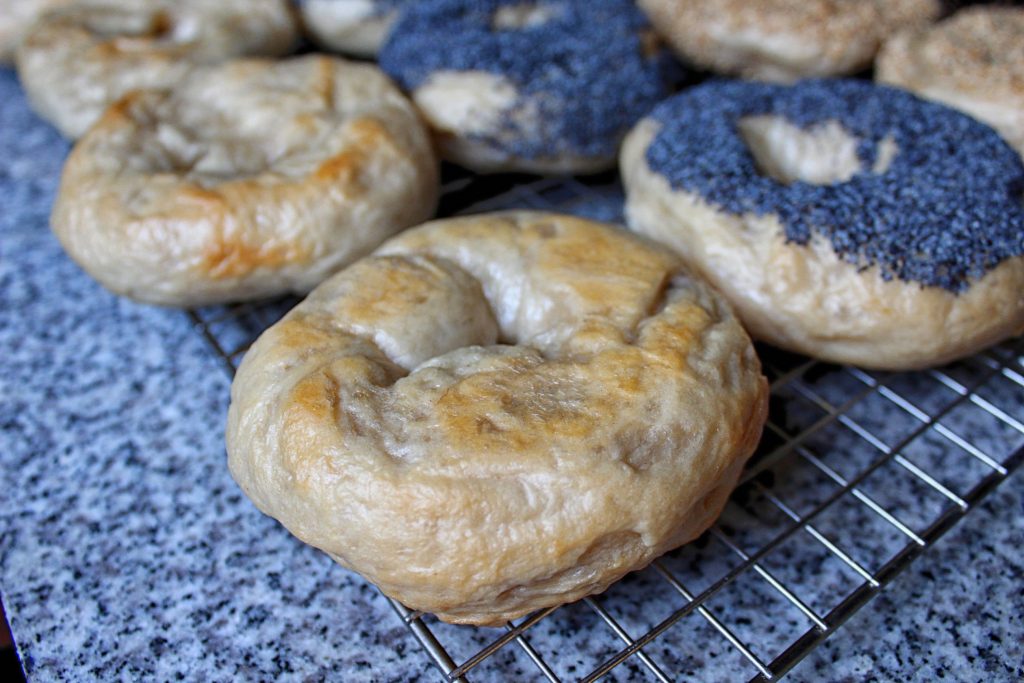
Still, I’m pleased with the result. I have also been experimenting with homemade cream cheese this month and tried my homemade bagels first with a schmear of that.
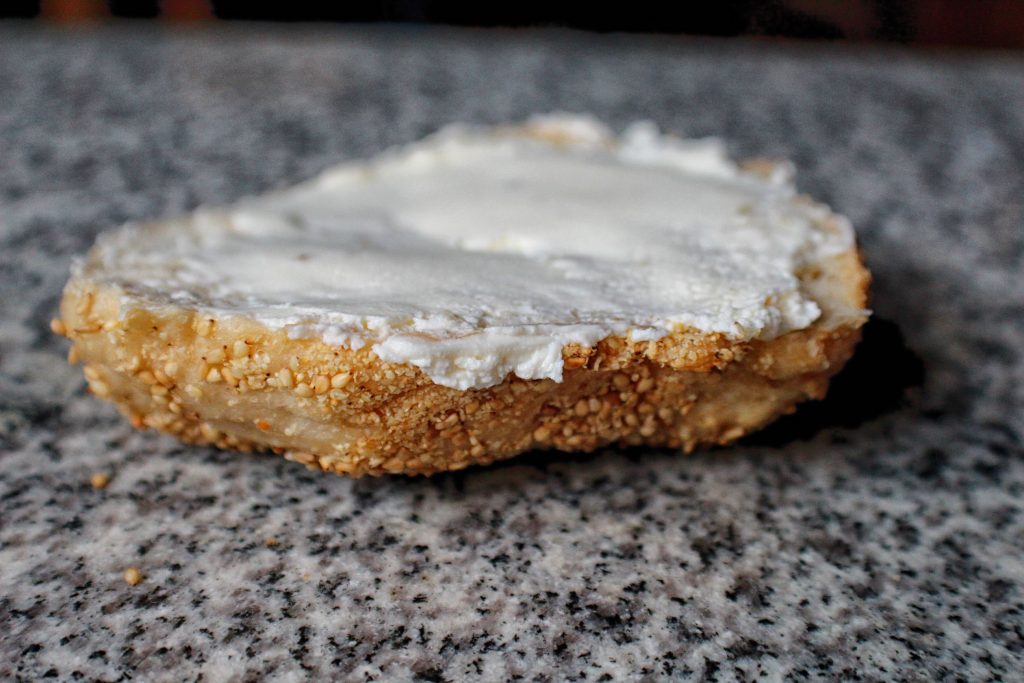
This was excellent. The best bagel I’ve ever had in my life was a sesame seed bagel, still warm from the oven, from St-Viateur bagel shop in Montreal last year while traveling there to try Smoked Meat sandwiches. It was so good it didn’t even need cream cheese, it could be eaten out of hand. This was not quite that good but freshness counts for a lot with bagels. It was close. I was ready for a sandwich. All I needed was pickles and mustard.
Mustard
Well, we already covered this. Colman’s sells prepared mustard, but Colman’s mustard powder is the way to go to get the true sinus clearing power of a spicy mustard. The powder is mixed with a roughly equal volume of water and allowed to sit for about 10 minutes. That’s it.
Sandwich
First we’ve got to slice that salt beef. The grain on the flat runs diagonal to the length of the flat, so we start on a corner and work our way across, cutting slices about a half inch thick.
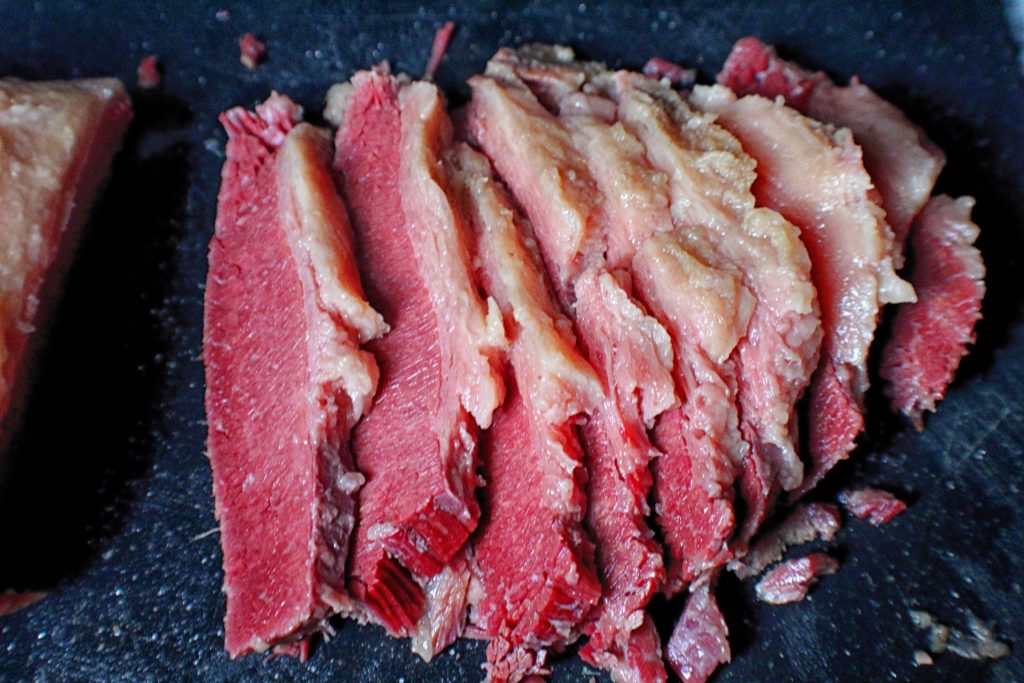
The still-warm bagel–I think I’ll use poppy seed for this
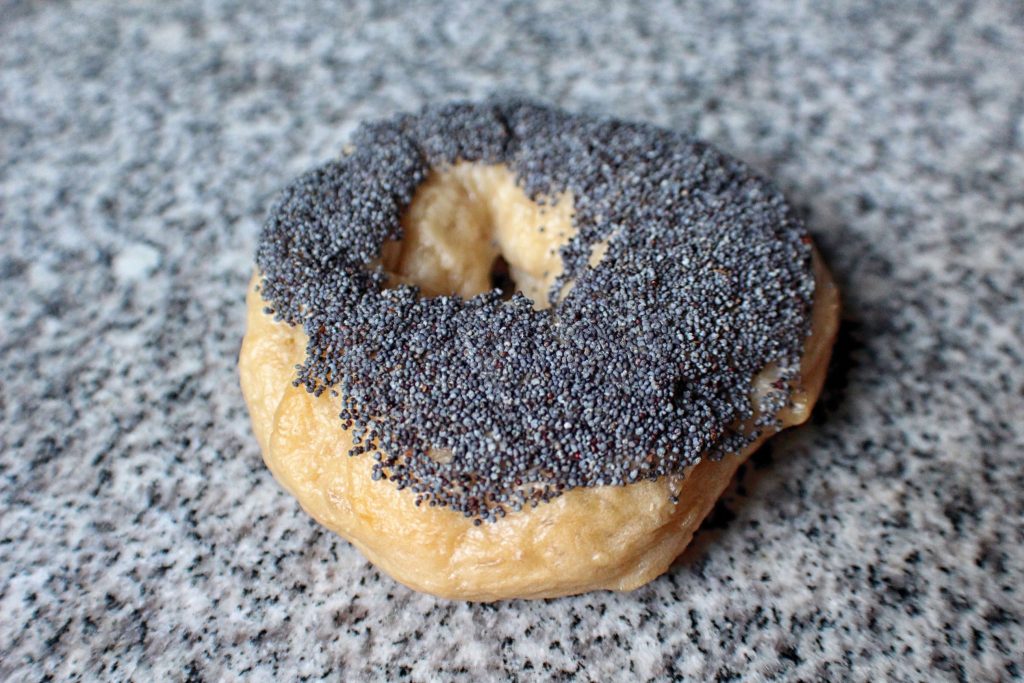
The still-warm bagel is cut in half and split open.
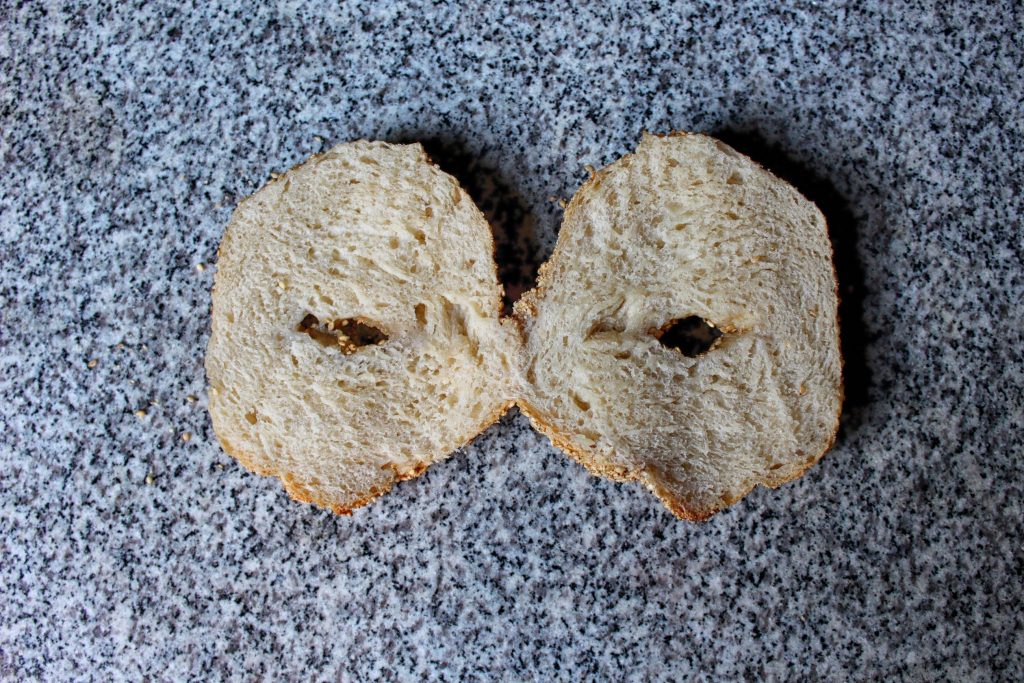
We’re going to stack a couple layers of those half-inch slices of salt beef into this guy and load them up with spicy mustard.
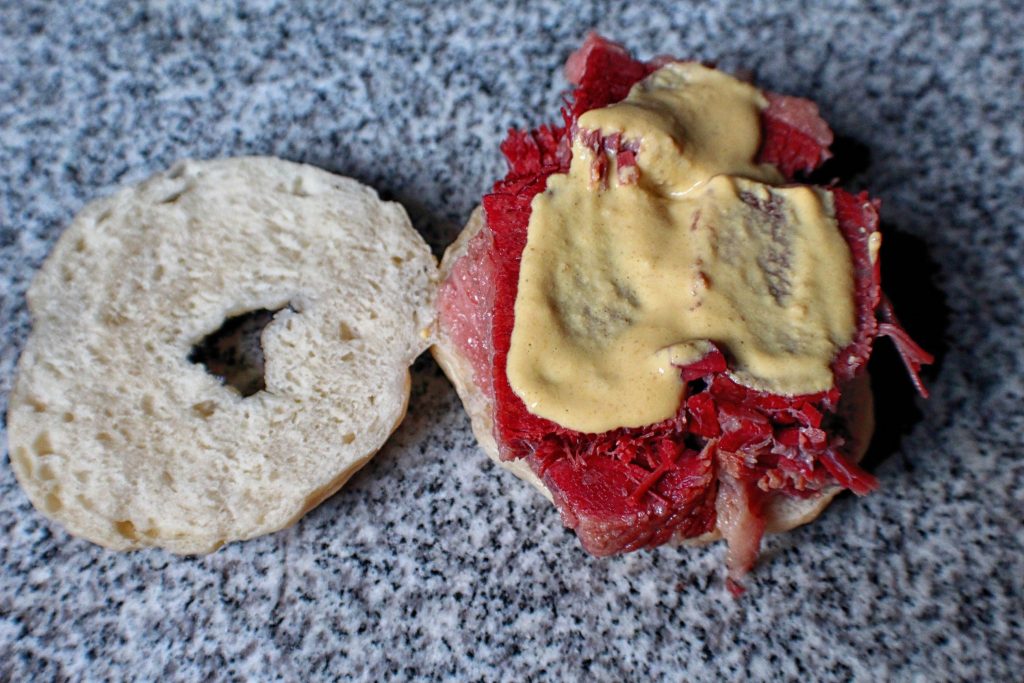
Oh man. Look at that.
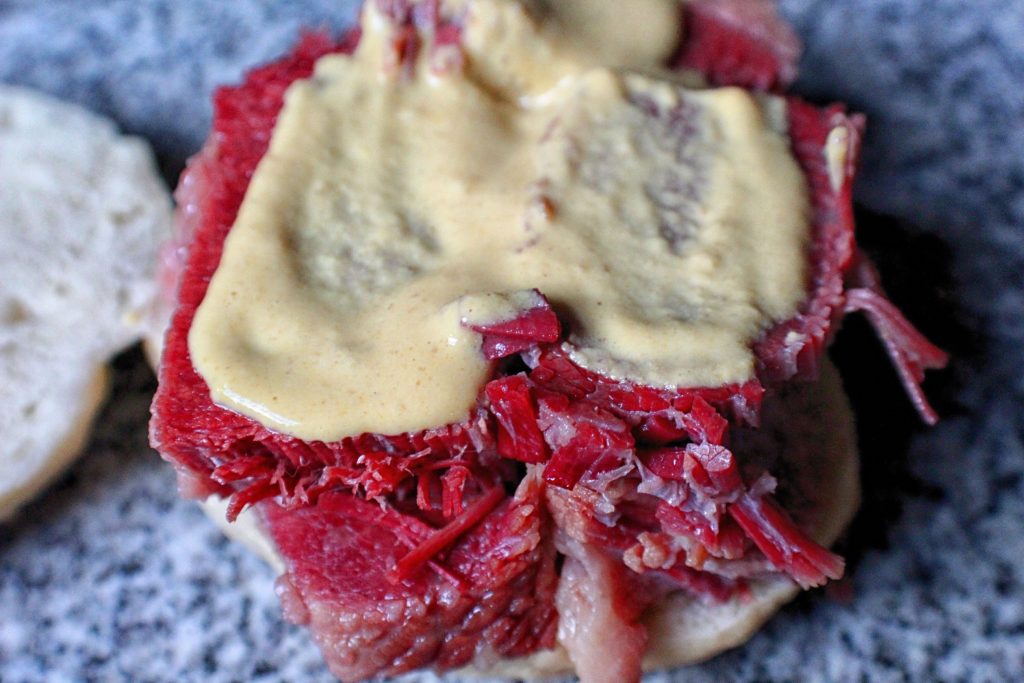
OK, so close that bagel up to make a sandwich like so.
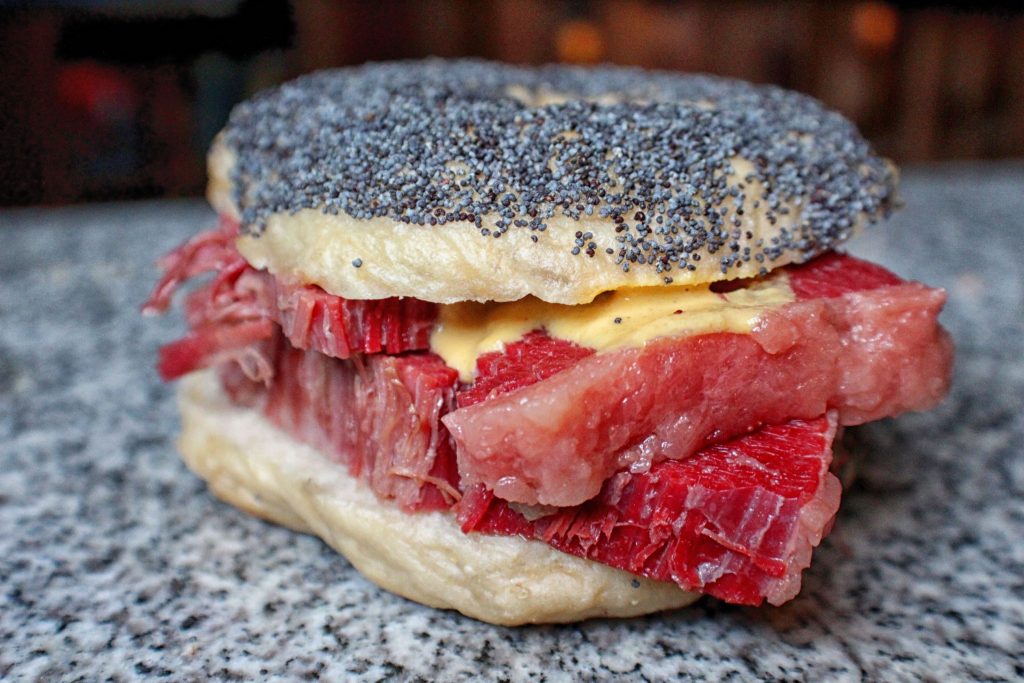
And… cut it in half? Why not? Who doesn’t like a thick meaty cross-section.
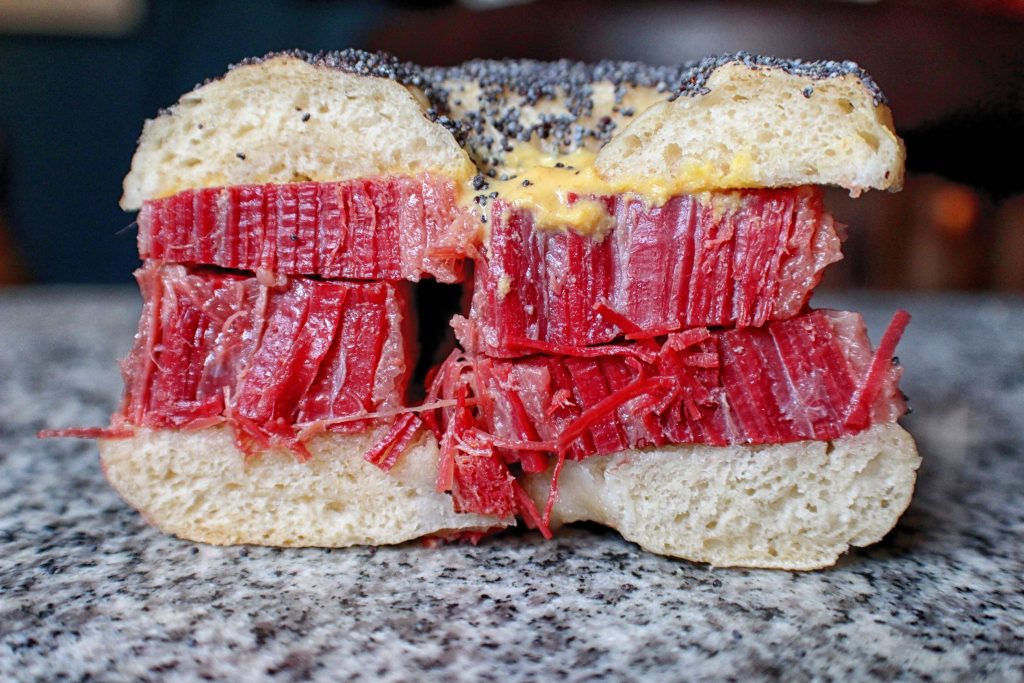
Oh. Oh. I’m sorry guys, I’ll need a minute.
I mean, I forgot the pickles. That’s OK, right?
Pickles
Making pickles is not a difficult thing to do. It’s not even all that time consuming. Yes, they’ll need to sit around for a few days, but all you need is a few small cucumbers, a brine with water, kosher salt, some vinegar (I used an organic cider vinegar that frankly was a bit on the old side, some stringy bits of mother starting to show), garlic, and pickling spices. I don’t much like sweet pickles so I leave out sugar. The fruitiness of the cider vinegar lends an impression of sweetness anyway. Bring the brine to a boil, cut the blossom ends off the cucumbers and stuff them into a jar, pour the brine over, and let it sit for a few days.
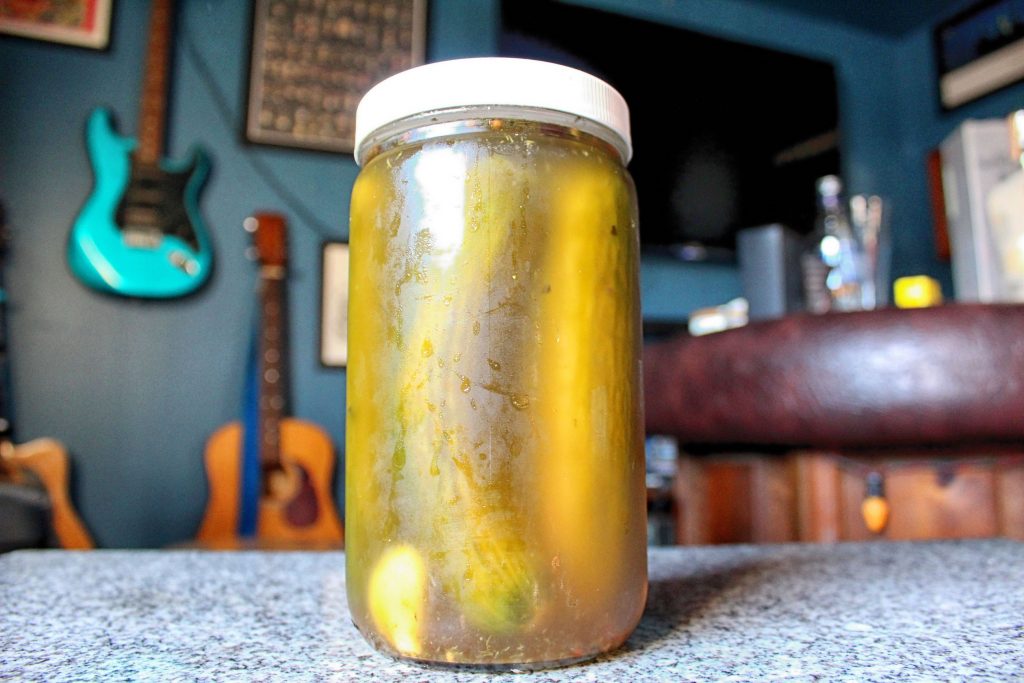
OK so yes, I had the pickles ready ahead of time, I just forgot to put them in the sandwich. Here’s the other half of that sandwich with a few pickle slices in it.
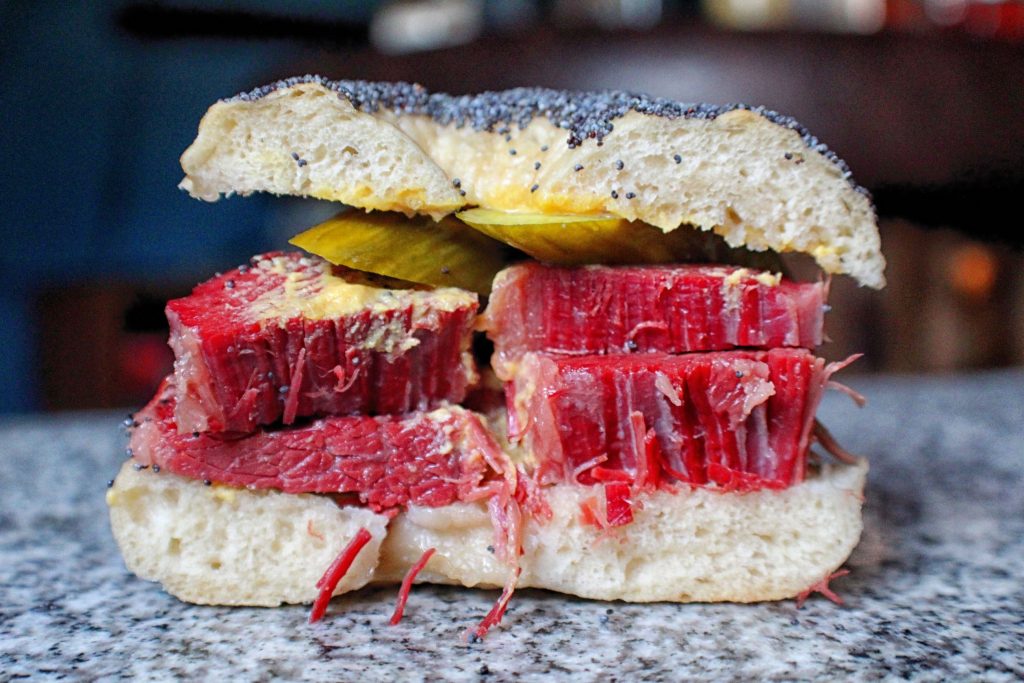
Sandwich, Take Two
Still, it’s not quite the same, is it? Not to mention that the salt beef bagels sold in Brick Lane are constructed entirely differently. The bagel is cradled in wax paper, not laid on a plate. It is not sliced completely in half but a hinge is left connecting the two halves. The salt beef is stuffed into the semi-split bagel as if it were a hot dog being inserted into a bun, pickles tucked between two to three thick slices of beef and mustard haphazardly swiped over the whole, which is tucked into a brown paper sack and handed to the hungry customer on the go. It is not a carefully constructed stage-managed thing to be photographed lovingly. It’s a street food, quickly assembled and on to the next.
OK.
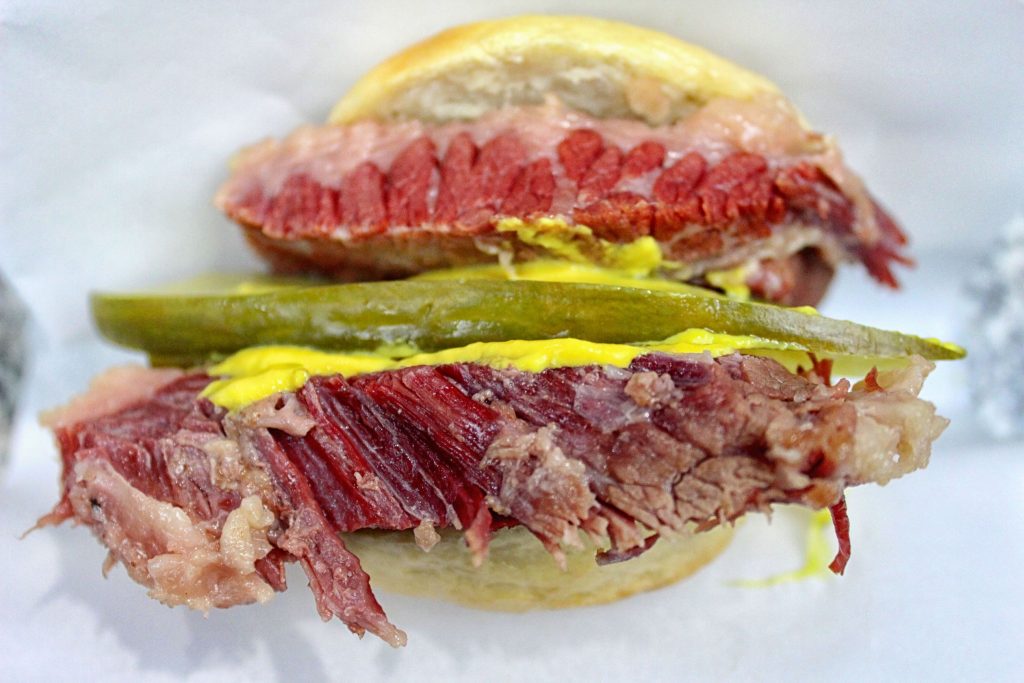
This is the sandwich as street food, wrapped in wax paper, hinged at the bottom, portable and contained, though still a little sloppy. This is an indulgent breakfast, a lunch on the go. This is a busy man’s dinner or a drunken late night snack. Don’t be fooled, though–that wax paper won’t keep your fingers from getting greasy or your hands from smelling like pickles and mustard the rest of the day. It certainly won’t pick any little stringy bits of beef out of your teeth for you.

I like sandwiches.
I like a lot of other things too but sandwiches are pretty great






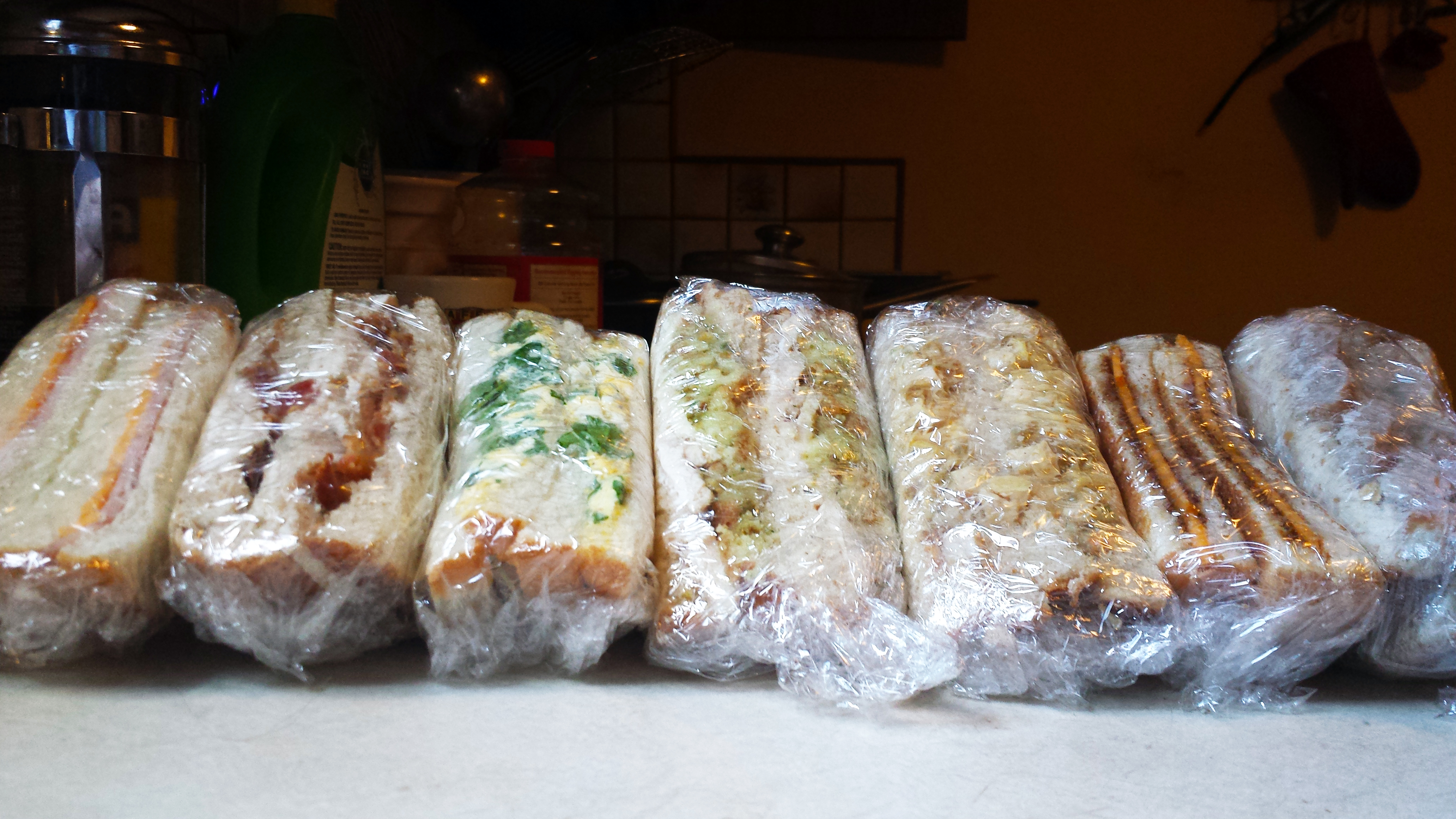






Recent Comments